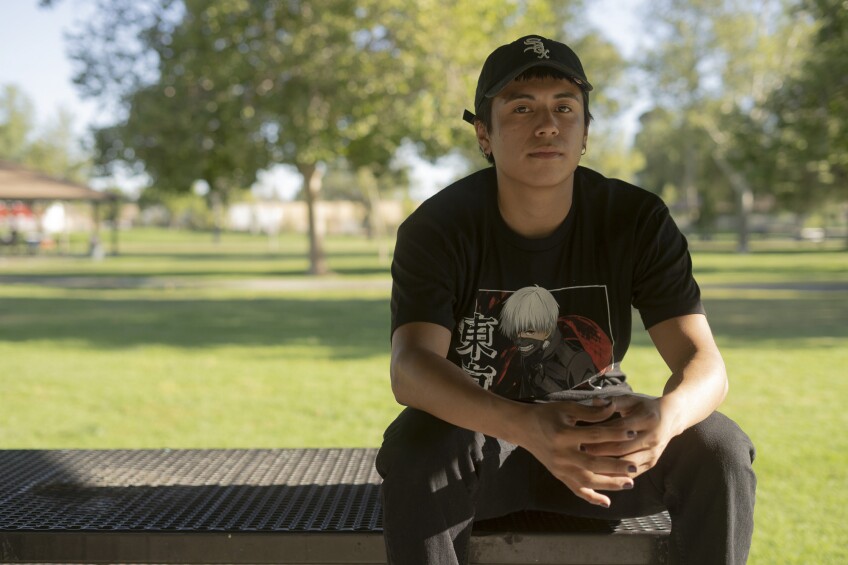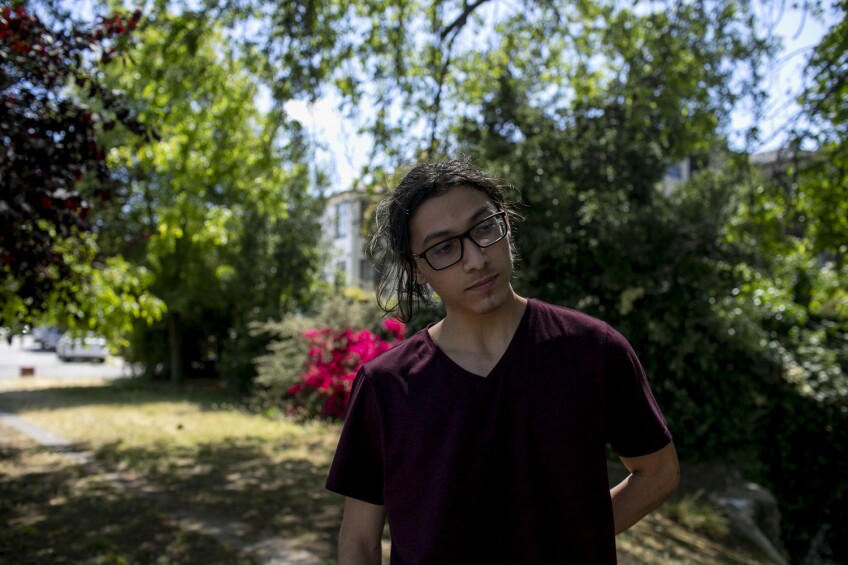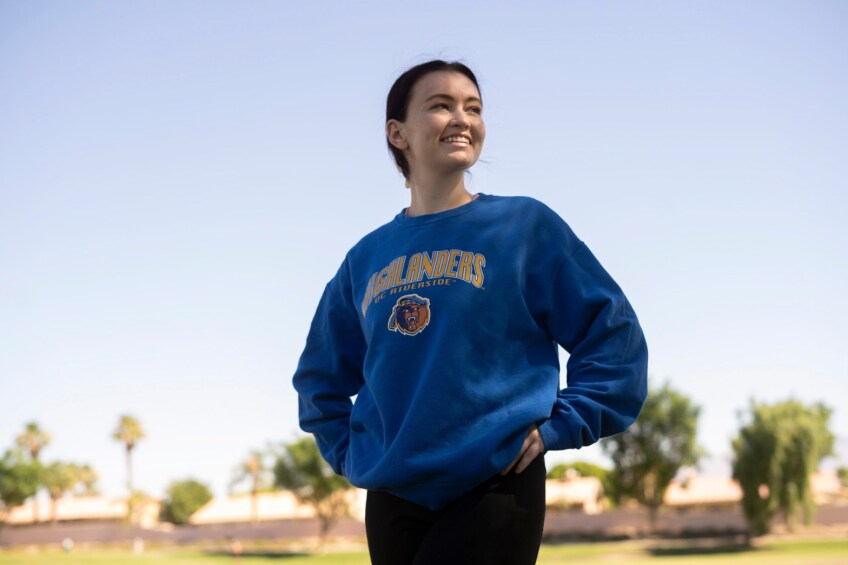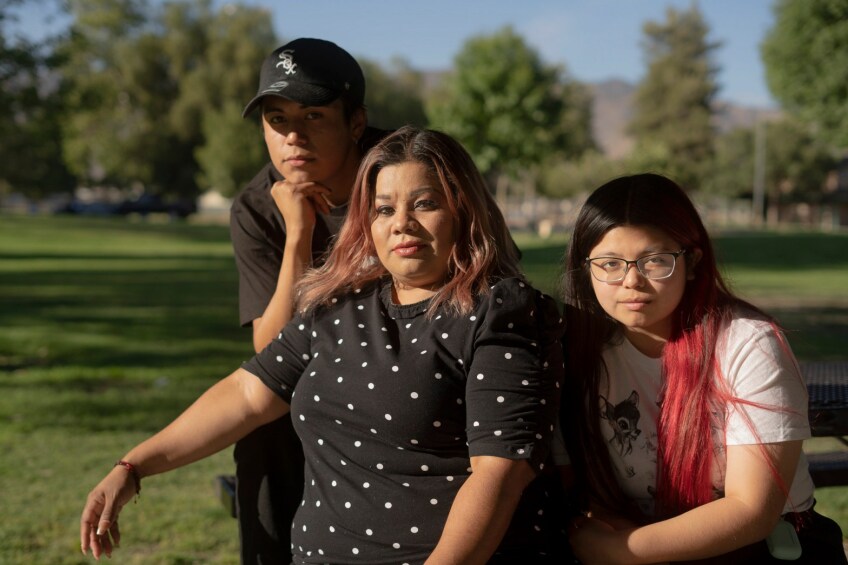How Some College Counselors Are Fighting Back Against Pandemic-Induced Enrollment Decline

This story was published June 16, 2021, by CalMatters.
Story by Charlotte West and Angel Fabre
In early June, 19-year-old Brian Cruz was on a break from his warehouse job at Amazon, listening to music. He scrolled through the messages on his phone and saw an email from the college and career center at his old high school in Hemet, a high desert town in Southern California.
Even though Cruz graduated from Tahquitz High School last year, the email invited him to make an appointment with a school counselor. Last spring, Cruz decided to put off college and work while he waited out the pandemic.
But a year of packing boxes at Amazon and a lifetime of seeing family members work manual labor made him anxious to go back to school as soon as possible. “I was happy to get that email, because I really didn’t know what to do,” he said.
Cruz is one of the first students to participate in College Comeback, a counseling program launched by the Riverside County Office of Education at the end of May. A team of six spends 25 hours a week reaching out to the high school class of 2020 after data revealed that 2,300 fewer students — a decline of around 8% — went to college in fall 2020 compared to the year before.
The numbers from Riverside County mirror trends in other parts of the state and the country. Nationally, college going rates for students straight out of high school were down 13% overall and 22% at community colleges in fall 2020, according to the National Student Clearinghouse Research Center, a non-profit that tracks enrollment data. Experts attribute the enrollment decline to the COVID-19 pandemic and aren’t sure how soon — or whether — those numbers will bounce back.
“That’s one in five freshmen who would have been expected to go to a community college this fall that simply didn’t show up,” said Doug Shapiro, executive research director at the Clearinghouse, during a presentation for the Education Writers Association in May.
Coming Back
A few days after getting the email from the school counselor, Cruz logged onto a Zoom appointment with counselor Yuri Nava. He told her he’d been accepted to University of California Riverside last year, but didn’t enroll after he found out classes would be online.
Nava informed him he’d missed the Nov. 30 deadline for the upcoming school year, so he’d have to wait until fall 2022 to start at UC Riverside. No one had told Cruz that he had the option to defer his admission a year, he said.
Nava then walked Cruz through his options, encouraging him to think about community college.
She worked with Cruz on filling out his financial aid application, also known as the FAFSA, and booked another appointment to complete his application and select classes at Riverside City College.
“I don’t know where I even have to begin,” he said. “I’ve been talking to people from (colleges) and they haven’t really been very clear on what I actually have to do to get into the school and choose the classes. I mean I tried it, but I really couldn’t do it myself.”
College Comeback has been a boon to students like Cruz, but time will tell how many students the program will be able to reach. Outreach to students last summer showed how challenging it can be to get large numbers of students to reengage in higher education, but also how effective one-on-one counseling can be for individual students.
How It Works
After they graduate, students lose the support they’d normally get from their high school counselors. College Comeback is the first program of its kind in California, specifically targeting recent graduates who want to go to college but don’t know how.
Students who graduated from Riverside County high schools last year can sign onto a booking website to make different types of appointments to explore postsecondary options, fill out a FAFSA or California Dream Act form for undocumented students, fill out a college application and learn about career and technical programs or military service.
The effect has been that this pandemic has been exposing and widening existing inequities in our society.Doug Shapiro, executive research editor at The Clearinghouse
The county has paid counselors like Nava a stipend to take on the extra workload via money previously allocated to things like travel. Whereas high school counseling often involves group workshops, the alumni program focuses on individual appointments, said Catalina Cifuentes, director of college and career counseling for Riverside County.
Because counselors are also trained mental health professionals, they also provide social and emotional support for students who might be facing challenges that impact their educational choices, Nava said.
College Comeback also collaborates with colleges and universities and stays in touch until the student has registered for classes. “We don’t want the students to get a run around,” Cifuentes said.
The program got off to a slow start because district leaders were worried about diverting attention from the current class of seniors, but currently has approval to continue for the foreseeable future, according to Cifuentes. Education experts say there’s ongoing need for postsecondary support for all graduates that will persist beyond the pandemic.
Statewide, almost 22,000 fewer seniors from the class of 2021 have filled out the FAFSA compared to this time last year. This summer, Riverside counselors will also be working with 2021 graduates to make sure they complete all the steps necessary to go to college this fall.
A Big Problem
Clearinghouse’s Shapiro said the college-going data is alarming.
“It continues to get worse when you drill down into some of the demographics within that,” he said of the national data. “For Black students, Latinx and Indigenous students, in particular, the declines were almost twice as steep.”
San Diego County, for example, saw a drop in college-going seniors by around 11% with around 16,000 of the county’s 26,500 graduates headed to college in 2020. The drop was even more “catastrophic” for some groups: 17% for low income students, 24% for Native American students and 33% for English language learners, according to Shannon Coulter, director of research and evaluation at San Diego County Office of Education.
While experts hoped students who disappeared in the fall would return in the spring, so far that’s not the case. Recent spring enrollment data from the Clearinghouse show similar declines in enrollment between this year and last spring.
“The effect has been that this pandemic has been exposing and widening existing inequities in our society, even to the extent of reversing the progress that we’ve made in recent years around closing the equity gaps in terms of access to college,” Shapiro said.
That has borne out in Riverside County, which had one of the worst college-going rates in California back in 2013 at around 54% percent, according to Cifuentes, the Riverside County counseling director. Through concerted efforts aimed at improving college going, including professional development for counselors and a huge push for FAFSA completion, the county had been able to boost college enrollment rates to more than 60% as of 2019.
But between 2020 and 2019, the enrollment rate dropped almost back down to the 2013 levels. Cifuentes said the pandemic “erased all of the progress we’ve made in the last seven years.”
Shapiro said that colleges need to figure out how to reach not only current high school seniors but also those who graduated last year. “They’re disconnected now from education,” he said. “These are students that if they don’t make it back, they’ll be disadvantaged in terms of their skills, their employability, their earning potential. Not just themselves, but their families, their communities, and our whole country… will suffer from that.”
Troubling Declines
While statewide data isn’t available, the number of California high school graduates from the class of 2020 who went to college dropped in several of the state’s most populous districts compared to the year before, according to Clearinghouse data provided to CalMatters. All eight districts and four counties for which CalMatters viewed data saw a decline in graduates going directly to college, ranging from 2.5% in San Mateo Unified to 13.1% in Fresno Unified. Districts with a higher share of low-income students or students enrolling at community college saw bigger drops. That translates into thousands of California students who didn’t go to college last year.
In Los Angeles Unified, the largest school district in California, college-going rates decreased from 68% to 59% between 2019 to 2020, a drop of more than 2,600 students, according to Clearinghouse data. Oakland Unified dropped 11% with around 46% of its 2020 grads headed to college, while San Francisco Unified reported a 6% decline.

The decline in college going rates has significant implications for students, colleges and California. Following national trends, California has made significant progress over the last several years in improving college going rates, especially for groups that are historically underrepresented in higher education, so the recent declines are troubling, said Hans Johnson, director of the Higher Education Center at the Public Policy Institute of California.
“We know that going to college is one of the most important ways that we continue to achieve economic mobility in our state,” he said.
Johnson said the question is how many high school graduates who didn’t go to college because of the pandemic will eventually go back. “Anytime a student stops out, for whatever reason, they’re less likely to ever return [to college], even if they have good intentions,” he said.
Struggling and Juggling
Students and counselors cite a number of reasons for the decline. Many, like Cruz, wanted to avoid online learning or didn’t have reliable Internet access, while others became primary wage earners in their households, or took on care responsibilities. Some students who tried to enroll in the fall ended up dropping their classes because they struggled with online classes. Colleges have also reported increases in students who are only attending part time.
Some members of the class of 2020 are taking the more traditional “gap year,” where they’ve been admitted and defer a year. At Stanford, for example, 378 first-year students — or around 20 percent of the incoming class — opted to wait until fall 2021.
One of them was Langston Buddenhagen, a 2020 grad from Oakland Tech High School. He wasn’t thrilled at the prospect of spending his first year of college sitting in front of his computer. “The main goal [of my gap year was] to avoid the COVID disruptions and try and wait out as much of it as I could,” he said.
He started his own business tutoring younger students and volunteered with a task force in Oakland working on police reform in the wake of the George Floyd murder. He also interned with the San Francisco district attorney’s office.
The main goal [of my gap year was] to avoid the COVID disruptions and try and wait out as much of it as I could.Langston Buddenhagen, Oakland Tech High School 2020 grad
Nineteen-year-old Andres Martin, a graduate of Skyline High School in Oakland, had applied and been accepted to several out-of-state colleges and other institutions in Southern California. But when the pandemic hit, his flight attendant mother was unable to work and his dad, an electrician, had a hard time finding jobs.
As a result, Martin had to reconsider where, and whether, he wanted to go to college. He got into UC Riverside, but decided it would be too expensive to move so far away from home. “It didn’t seem like I had much of a choice of where I could go,” he said.
Like many students, Martin also worried about his ability to be academically successful with remote learning. “I knew that I would keep struggling since in the pandemic, it was really hard to stay motivated, stay focused, stay on task, just not being in a classroom situation,” he said.
Martin considered community college, but realized he’d have to study there for two years and transfer. He decided to instead focus on community service and a fellowship program where he learned how to code in order to strengthen his college applications. He applied again for fall 2021 with support from College Track, a non-profit he’d worked with throughout high school that helps students apply to and transition to college.
Now, he’s planning to study computer science next fall at UC Santa Cruz. “I’m pretty excited to be able to get back on campus,” he said.
Impact on Colleges
For fall 2020, overall enrollment across the University of California’s nine undergraduate campuses remained relatively flat, but the system also enrolled a record number of in-state residents. The California State University system also had its largest-ever student body for the fall 2020 term, collectively enrolling 485,549 students.
But COVID-19 ravaged California’s community colleges in California — which vastly outnumber UC and CSU campuses — to the tune of an 11% drop in students, according to system data.
This has been especially problematic in regions where most students go to community college. Santa Cruz County, on the central coast, had a drop of 7% in college going and Shasta County, in Northern California, reported a decline of 8%. In Shasta, all of that drop was at a single place, Shasta College, which is the only higher education in a 75-mile radius.
Johnson of PPIC said it’s good news that the UC and CSU systems have fared relatively well so far, but the decline in community college enrollment could have knock-on effects a few years down the road.
“If those students aren’t coming in as a front end, then we’re not going to see them in that transfer pool either,” Johnson said.
Proof of Concept
Educators in Riverside County realized the need for the College Comeback program last summer after working with students like Ariel Jennings, who had just graduated from La Quinta High School near Palm Desert. The 19-year-old had been admitted to UC Riverside, but didn’t accept the school’s offer because she was unsure of how much financial aid she was getting. “I missed the deadline, like, twice,” she said. “And I didn’t understand financial aid or the paperwork or anything like that.”
Jennings didn’t know where to turn. “At that point, we weren’t in school anymore so I couldn’t go to a high school counselor for help either,” she said. “My parents and I just felt really alone in the process.”
She tried to contact UC Riverside herself, but “it’s really frustrating sending emails and then getting a reply two weeks later, and no one actually talking to you,” she said.
The responses Jennings did get were vague, telling her to email other departments on campus. So she decided to enroll at College of the Desert, “since classes were going to be online anyway.”
And then later in the summer, Jennings got a phone call. “I thought it was just one of those spam calls or something,” she said. “But I answered anyway.”
The voice on the other end of the line was counselor Yuri Nava, who told Jennings she could help her. Nava explained Jennings’ financial aid award and told her it wasn’t too late to go to UC Riverside after all.
Jennings was one of around 1,100 recent high school graduates from Riverside County who had been admitted to UC Riverside last year but had not accepted their offer or enrolled at another UC. County counselors and college admissions officers split the list and started reaching out in early July. Around 20 of those students who were contacted by the county ended up enrolling at UC Riverside, with several more getting help to go to community college.

With the pandemic in full swing, last year’s admission season was confusing for colleges, students, and parents, said UC Riverside Associate Director of Undergraduate Admissions Alex Ruiz. He said the university worked with the county to increase outreach for what he characterized as an anomalous year, and that this year should be a return to relative normalcy.
Last week, Jennings just finished her first year at UC Riverside as a political science major. “I’m a first generation [student], so the process was kind of hard, and I really needed the extra help that I got,” she said.
Breaking the Chain
In Riverside, Cifuentes hopes that College Comeback will show the need for ongoing postsecondary counseling that helps bridge the gap between the K-12 system and higher education.
Her dream would be to have a designated counselor in each district who works with graduates. Alumni counselors are not a new concept; it’s a common position in private schools and some public charter schools like the Knowledge Is Power Program, or KIPP, network.
“If I can show the impact of how many students we served, [the program] pays for itself” in terms of return for the community, she said.

Since May, around 30 students have had appointments, but several others have gotten assistance via text and email. Cifeuntes expects the number to pick up as more alumni hear about the program.
As for Cruz, he’s said he’s excited to start at Riverside City College this fall. He wants to study entrepreneurship and accounting so he can start his own business in the future.
His mom, Rossy Elizabeth Diaz, is equally excited. She’s been encouraging Cruz to go back to school, and is looking forward to Cruz’ 16-year-old sister heading to college in a few years.
Diaz appreciates the support Cruz got through College Comeback. “I feel really proud, really happy because I had my first kid when I was 17, so I didn’t have the chance to go to school,” she said. But “I had the chance to help them break that chain, for them to do something different from…their parents.”
Charlotte West is a reporting coach and training coordinator with CalMatters College Journalism Network. Angel Fabre is a fellow with the network. Mikhail Zinshteyn and Matthew Reagan contributed reporting to this story. Zinshteyn is CalMatters higher education reporter and Reagan is an intern with the CalMatters College Journalism Network. Data visualization done by Erica Yee and Frida Qi.
This story was supported by a grant from the Solutions Journalism Network.
CalMatters.org is a nonprofit, nonpartisan media venture explaining California policies and politics.







